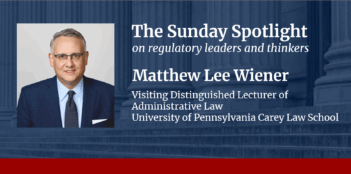
ACUS assesses the changing landscape of how agencies use new technologies to hold hearings.
For a century and a half, federal agencies had two options when it came to adjudication: bring the participants together at a central location, or communicate in writing.
Then came the telephone. Invented in the nineteenth century, the telephone only became commonplace in American homes after World War II. As access increased and networks expanded, Americans grew accustomed to conducting business by telephone—even for matters with the government. Conference calling made remote meetings a practical and popular option.
When it came to government proceedings, administrative agencies responded to these developments by using the telephone first to communicate with parties and then to conduct hearings, as a way to save time and money and to manage mounting caseloads.
One of the first tribunals to routinize the use of telephones was the Departmental Grant Appeals Board within the U.S. Department of Health and Human Services (HHS). The Board adopted a rule in 1981 permitting members to conduct prehearing and informal conferences by telephone. Telephone proceedings were popular among Board members, and soon they conducted most of their hearings by telephone.
Based on a 1986 study of the Department Grant Appeals Board, the Administrative Conference of the United States (ACUS) identified the telephone as an important innovation in case management. Telephone proceedings reduced costs, saved time, and simplified scheduling. ACUS recommended that government agencies “take full advantage of telephone conferences as a means to hear motions, to hold prehearing conferences, and even to hear the merits of administrative proceedings where appropriate.”
But telephone hearings were not universally welcomed. When another HHS agency, the Health Care Financing Administration, proposed hearing Medicare appeals by telephone in 1987, members of the U.S. Congress voiced concerns and declined to fund the program. Skeptics understandably wondered: Were telephone hearings fair, and did they comport with due process? Would the use of telephone hearings affect substantive outcomes? Should agencies be allowed to compel parties to participate by telephone, or should telephone hearings be optional?
The telephone was quickly surpassed by another technology: video teleconferencing. Rapid technological and communications improvements by the early 1990s made video teleconferencing a viable option for conducting adjudicative proceedings. Through systems of cameras, microphones, powerful computers, and high-capacity communications networks, adjudicators could efficiently manage proceedings involving participants in video conferencing equipped facilities across the country
Federal agencies, especially those with large numbers of cases and mounting backlogs, saw the potential for video hearings to reduce costs and facilitate workload management. Some agencies, such as the Social Security Administration, the immigration courts, and the Board of Veterans’ Appeals, became early adopters.
But video hearings understandably prompted the same questions as before: Were video hearings fair, and did they comport with due process? Would their use affect substantive outcomes? Should agencies be allowed to compel parties to participate by video, or should video hearings be optional?
Recognizing both the potential benefits and drawbacks of this increasingly prevalent format, ACUS issued recommendations in 2011 and 2014 to help agencies determine when and how to conduct video hearings fairly, accurately, and efficiently. In 2015, ACUS created a handbook on the subject.
Although web conferencing software programs existed by the mid-2010s, they were not always workable, reliable, or widely accepted enough for adjudicative proceedings. And many participants still lacked access to a suitable device or internet connection. Access rapidly expanded, however, as technologies and networks improved, grew more affordable, and became embedded in everyday life.
By 2018, most American households had access to a computer and a broadband internet subscription. Administrative agencies began eyeing the use of programs such as Skype—and later its descendants Zoom, WebEx, and Microsoft Teams—but the old questions remained: Are hearings conducted using web conferencing programs fair, and do they comport with due process? Does their use affect substantive outcomes? Should agencies be allowed to compel parties to participate virtually, or should virtual hearings be optional?
These questions persisted, and then came the COVID-19 pandemic. As states imposed public health measures and agencies closed their facilities, processes that required access to government facilities, including in-person and traditional video teleconferencing proceedings, became unworkable. Agencies had no choice but to work with stakeholder communities to develop and deploy remote processes rapidly. Virtual proceedings, often conducted completely outside a hearing room using commercially available web conferencing software programs, became an indispensable element of adjudicative processes.
This unintended experiment with virtual hearings has yielded an unprecedented flurry of innovation and an extraordinary conversation over the role of technology in administrative adjudication. Since March 2020, agencies and the public have learned a great deal about what works and what does not. Some agencies will undoubtedly return to in-person proceedings as soon as possible. Others will stay virtual, or retain a virtual option for willing participants. Many will adopt a hybrid model, in which some people participate in person, others by video, and perhaps others by telephone.
To capture agencies’ experiences during the pandemic and identify best practices for the future, ACUS launched a project to study the use of virtual hearings in agency adjudication. Members drew on their own personal observations over the past year, a study of agency practices by the Center for Legal & Court Technology, additional legal analysis, and an extensive database of agency policy developments since March 2020. The result was ACUS Recommendation 2021-4, Virtual Hearings in Agency Adjudication.
This recommendation acknowledges the real benefits that agencies and members of the public can derive from properly implemented virtual-hearing programs.
Virtual hearings are inexpensive, rarely require travel, and make scheduling easier. Their use also has the potential to expand access for members of underserved communities, including people with disabilities who may face difficulties traveling or appearing in public settings, people who live in rural areas far from hearing facilities or qualified representation, and low-income individuals who may face difficulty securing transportation, taking time off work, or arranging for childcare.
But the recommendation also candidly recognizes the challenges that virtual hearings can pose for other members of underserved communities and in certain situations. Virtual hearings can suffer from technical glitches, and their effectiveness depends heavily on individual participants’ level of comfort and ability. And although most Americans now have access to a home computer and high-speed internet access, disparities in digital access remain across race, income, age, and other demographic groups.
Recognizing both the benefits and challenges of virtual hearings, ACUS’s recommendation identifies factors that agencies should consider to determine whether virtual proceedings are appropriate for use in their programs. The recommendation also identifies best practices for managing virtual-hearing programs, to ensure that they are implemented fairly and efficiently.
Specific recommendations address practical matters, such as developing guidelines for conducting and participating in virtual hearings, ensuring privacy and cybersecurity, managing records, providing adjudicators with adequate hardware and facilities, training adjudicators and others, and supporting agency and non-agency participants. A follow-up project by ACUS will delve deeper into related issues of public access.
Given legitimate concerns about how different hearing formats impact procedural fairness, substantive accuracy, and participant satisfaction, Recommendation 2021-4 encourages agencies to actively monitor the performance of their virtual-hearing programs, solicit feedback from participants, and share best practices.
Informed by ACUS’s prior recommendations on telephone and video teleconferencing, ACUS’s most recent recommendation encourages agencies to “monitor technological and procedural developments,” to ensure that options for participation in agency adjudicative proceedings remain current and comport with participants’ expectations. Many officials predict hybrid proceedings will become the norm, but making these the only option would require careful planning and design. Telepresence could also become popular.
Increased reliance on machine-learning tools could affect the purpose and conduct of hearings. In the courts, at least, one futurist has even predicted uses for augmented or virtual reality. With paper hearings on the rise, however, agencies and the public can never discount the lasting value of an ancient technology well suited to the digital age: the written word. The only certainty, it seems, is that the future is frequently unpredictable.
The views expressed in this essay are those of the author and do not necessarily represent the views of the Administrative Conference or the federal government.
This essay is part of a four-part series on the Administrative Conference of the United States, entitled Improving Participation, Impact, and Fairness in the Administrative State.




